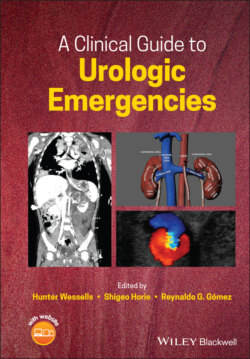Читать книгу A Clinical Guide to Urologic Emergencies - Группа авторов - Страница 39
Anatomy
ОглавлениеIt is imperative to have a sound understanding of renal anatomy, as it is foundational for understanding associated injury patterns, surgical approach/reconstruction, and comprises the basis of non‐operative management (NOM). The kidneys are paired retroperitoneal organs extending from vertebral levels T12 to L3. From deep to superficial, the layers surrounding the kidney are as follows: renal capsule, peri‐renal fat, renal fascia (Gerota's fascia), and para‐renal fat. Both Gerota's fascia and the renal capsule are responsible for tamponade of renal hematomas and they are both critical layers for renorrhaphy. The vascular supply consists of one main renal artery and vein, although about 25% of kidneys have accessory vessels. The internal structure can grossly be divided into the renal parenchyma and collecting system. The latter is comprised of minor and major calyces that coalesce into the renal pelvis. This distinction between the parenchyma and collecting system is important in renal injury grading (Table 2.1).
Table 2.1 AAST Renal injury classification, revised in 2018.
| Grade I | Contusion or nonexpanding subcapsular hematoma |
| Grade II | Nonexpanding perirenal hematoma |
| <1 cm cortical laceration without urinary extravasation | |
| Grade III | Cortical laceration >1 cm without urinary extravasation |
| Any injury in the presence of a kidney vascular injury or active bleeding contained within Gerota's fascia | |
| Grade IV | Laceration into collecting system |
| Segmental renal artery or vein injury | |
| Active bleeding beyond Gerota's fascia | |
| Segmental or complete kidney infarction due to vessel thrombosis without active bleeding | |
| Grade V | Main renal artery or vein laceration or hilar avulsion |
| Devascularized kidney with active bleeding | |
| Shattered kidney with loss of identifiable parenchymal renal anatomy |
Figure 2.1 The kidneys and their association with adjacent organs.
Source: figure courtesy of Daniel Burke, University of Washington.
The diaphragm, 11th and 12th ribs, quadratus lumborum, and psoas major surround both kidneys. Anteriorly, the right kidney is associated with the liver, duodenum, and right colic flexure; the left kidney is associated with the spleen, stomach, pancreas, left colic flexure, and jejunum (Figure 2.1). Even with the safeguards of their retroperitoneal location, they are susceptible to penetrating trauma and it is due to their close anatomical relationship with other organs that isolated PRI is rare.
